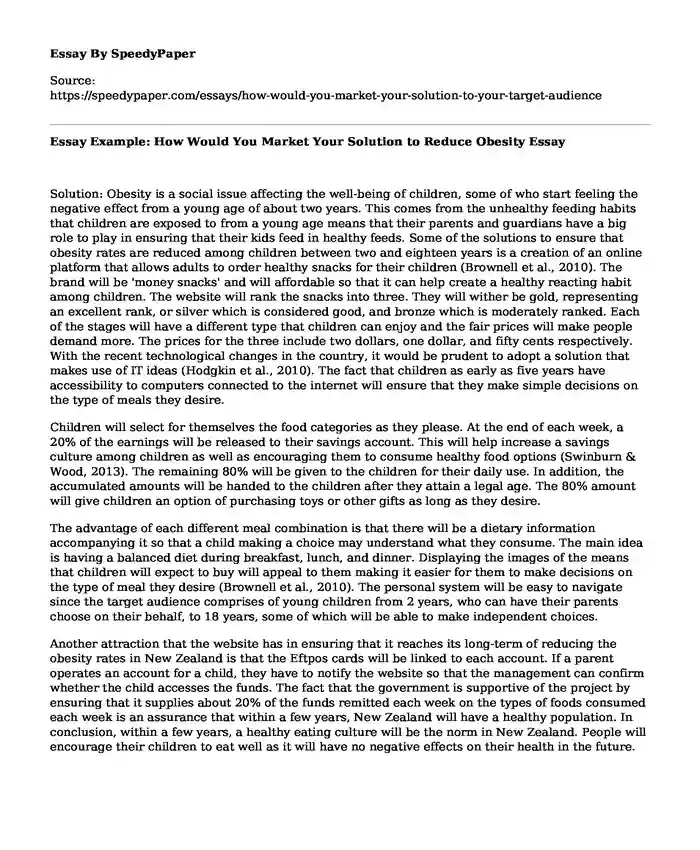
| Type of paper: | Essay |
| Categories: | Healthcare Community health |
| Pages: | 3 |
| Wordcount: | 682 words |
Solution: Obesity is a social issue affecting the well-being of children, some of who start feeling the negative effect from a young age of about two years. This comes from the unhealthy feeding habits that children are exposed to from a young age means that their parents and guardians have a big role to play in ensuring that their kids feed in healthy feeds. Some of the solutions to ensure that obesity rates are reduced among children between two and eighteen years is a creation of an online platform that allows adults to order healthy snacks for their children (Brownell et al., 2010). The brand will be 'money snacks' and will affordable so that it can help create a healthy reacting habit among children. The website will rank the snacks into three. They will wither be gold, representing an excellent rank, or silver which is considered good, and bronze which is moderately ranked. Each of the stages will have a different type that children can enjoy and the fair prices will make people demand more. The prices for the three include two dollars, one dollar, and fifty cents respectively. With the recent technological changes in the country, it would be prudent to adopt a solution that makes use of IT ideas (Hodgkin et al., 2010). The fact that children as early as five years have accessibility to computers connected to the internet will ensure that they make simple decisions on the type of meals they desire.
Children will select for themselves the food categories as they please. At the end of each week, a 20% of the earnings will be released to their savings account. This will help increase a savings culture among children as well as encouraging them to consume healthy food options (Swinburn & Wood, 2013). The remaining 80% will be given to the children for their daily use. In addition, the accumulated amounts will be handed to the children after they attain a legal age. The 80% amount will give children an option of purchasing toys or other gifts as long as they desire.
The advantage of each different meal combination is that there will be a dietary information accompanying it so that a child making a choice may understand what they consume. The main idea is having a balanced diet during breakfast, lunch, and dinner. Displaying the images of the means that children will expect to buy will appeal to them making it easier for them to make decisions on the type of meal they desire (Brownell et al., 2010). The personal system will be easy to navigate since the target audience comprises of young children from 2 years, who can have their parents choose on their behalf, to 18 years, some of which will be able to make independent choices.
Another attraction that the website has in ensuring that it reaches its long-term of reducing the obesity rates in New Zealand is that the Eftpos cards will be linked to each account. If a parent operates an account for a child, they have to notify the website so that the management can confirm whether the child accesses the funds. The fact that the government is supportive of the project by ensuring that it supplies about 20% of the funds remitted each week on the types of foods consumed each week is an assurance that within a few years, New Zealand will have a healthy population. In conclusion, within a few years, a healthy eating culture will be the norm in New Zealand. People will encourage their children to eat well as it will have no negative effects on their health in the future.
References
Brownell, K. D., Kersh, R., Ludwig, D. S., Post, R. C., Puhl, R. M., Schwartz, M. B., & Willett, W. C. (2010). Personal responsibility and obesity: a constructive approach to a controversial issue. Health affairs, 29(3), 379-387.
Hodgkin, E., Hamlin, M. J., Ross, J. J., & Peters, F. (2010). Obesity, energy intake and physical activity in rural and urban New Zealand children. Rural Remote Health, 10(2), 1336.
Swinburn, B., & Wood, A. (2013). Progress on obesity prevention over 20 years in Australia and New Zealand. Obesity Reviews, 14(S2), 60-68.
Cite this page
Essay Example: How Would You Market Your Solution to Reduce Obesity. (2022, May 31). Retrieved from https://speedypaper.com/essays/how-would-you-market-your-solution-to-your-target-audience
Request Removal
If you are the original author of this essay and no longer wish to have it published on the SpeedyPaper website, please click below to request its removal:
- Law Essay Example: Rights of Federal Crime Victims
- Talking To Grief By Denise Levertov: Essay Sample to Check
- Business Essay Example: Google v. China
- Essay Sample on the Topic of the Globalisation - One Belt One Road
- Free Essay: Gossip, Conversation, and Eavesdropping in Shakespeare's "Much Ado About Nothing"
- Essay Example on Hotel Industry in Singapore and Immigrants
- Essay Sample on Open Government Implementation
Popular categories




